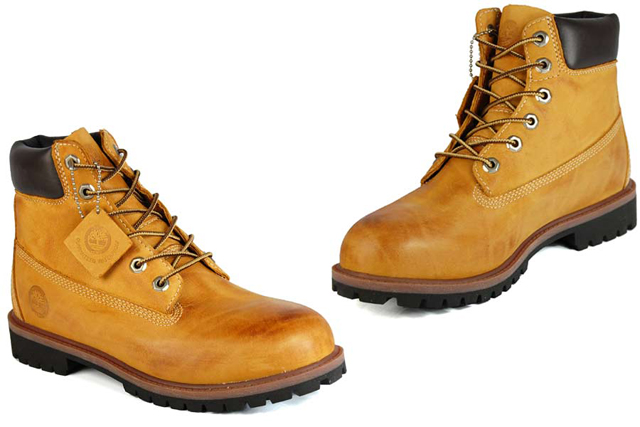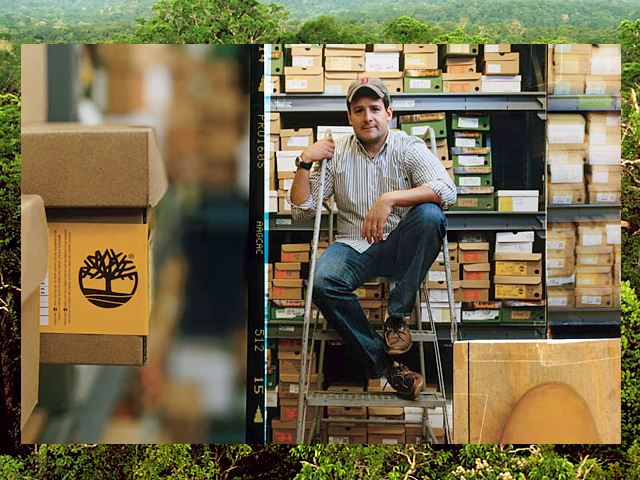Jeff Swartz, Honor is in the source

The yellow Timberland boot. The American boot, as hard working as Carharts, shearling, and blue jeans. Almost an artifact, the archetype that has not wavered or changed in style since the current CEO Jeff Swartz’ grandfather began the company. In 1960, the family company introduced innovative injection-molding technology which allowed for nearly 100% waterproof boots by attaching the soles to the leather tops without any stitching. This is craft! Craft that has been wildly successful, spread overseas, and is somewhat of an icon of the workers wardrobe.
Alot of assumptions come to mind when I see something with a high craft, or even folk value. I assume that detailed attention leads to eventual iconography, but most of all a good story usually lies behind the initial need of the object. Great sourcing, meticulous construction, and authenticity. Honor, too, plays a role in the molding of an archetype. My own assumptions add to the original story, which is needed to elevate any objects status from item to icon.
But ask CEO Jeff Swartz where the leather came from for his grandfathers beloved shoes prior to June 1, 2009, and this would be your answer:
“I don’t know.”
Impossible, right? How could you? How could he!? The food cart I frequent can tell me the name of the farm where my $5 chicken sandwich is sourced from, but Jeff Swartz can’t tell me where my $155 leather boots came from?
Jeff Swartz lays it out in an article he wrote himself for the Harvard Business Review’s Sept. issue. Generally articles written by CEO’s about their own company’s are hardly quote-worthy, but Mr. Swartz doesn’t realize how much he is revealing about his company. The backstory of the piece is that Greenpeace became tipped-off in 2009 that Timberland was sourcing some of its leather from illegally clearcut Amazonian rainforest, on tribal lands. Greenpeace emailed Swartz (to the tune of 65,000 angry emails) and Swartz then tells Harvard Business Review how to handle situations like this in a step-by-step CEO how-to, just in case this ever happens to you.
What I find so much more interesting than the backstory is, that Swartz reveals he had no idea where his leather came from for his iconic boots. It was a total mystery to him. Or anyone else that was advising him. Or his own leather sourcing departments. He says it best in this catch-all sentiment:
“As much as I didn’t want to admit it, Greenpeace was asking a legitimate question: Where was our leather coming from? Second on the list of things I didn’t want to admit was that we didn’t know the answer. We—our company, our industry—had until then [2009] never been asked, or asked ourselves, that question.”

Swartz then solidifies his position by the statement “I’m a bootmaker, not a cattle rancher” which apparently frees him from the responsibility of needing to know where the materials for his boots come from, or if they come from illegal sources. “That’s not a question that was keeping me up at night—at least not before that June [2009].” I read the rest of the article but couldn’t swallow any of his advice after his bootmaker/cattle rancher comment. I wonder if anyone else sees the flaw in this model?
There is a graph depicting Timberlands financials with the caption Despite falling revenues, Timberland’s net income is on the rise on the same page as a heading labelled The Origin of Hides. Is that relevant placement? But rather than get distracted by the article, I’d love to ask a couple of questions:
Is it craft if its origin is ambiguous? And is there honor in the source?
Once, during the construction of a building in Manhattan, Timberland put up a huge billboard that read: “There is honor in anything well made: bread, boots, a building.”
I cannot ignore the hollowed-out mechanism that is Timberland prior to June 2009. This is not a functioning system. For shareholders, obviously it is, but what does it say about your archetype if you care so little about it that you know nothing of its source? We mustn’t work like this. Swartz’ complaints about the weeks-long headache of being forced to find out if his leathers truly were coming from illegally cut Amazon tribal rainforest are only a cautionary blip. That work should have been done by his grandfather. As it turns out 7% of Timberlands leather did come from Brazil. They eventually made a statement that they will require ranchers to agree in writing that the forests were not tribal, nor clearcut. Which leads one to believe that indeed, something was happening prior to June 2009 in those jungles, but no one knew about it. Because “net income was on the rise.”
Am I blinded by anything that I am creating enough not to be able to find its true authenticity? Are there little Timberlands in my daily routine that I am overlooking? Certainly, source does not equal total authenticity, but it is part of the story, and if a story has holes, someone will find them and send you 65,000 angry emails. One final note, the Greenpeace activists discovered the discrepancies using Google Earth. Oh, internet, keep us honest, keep our honor.

Is there honor in the source? There ought to be, since “the source” represents people and places and God’s multicolored earth– and in all of those things there is much honor.
I agree, Kessia. Sources should be known, highlighted.
Sources largely seem to be associated with commons.
How could we move on in this century if our commons are not protected?
Excellent article.
The internet has been really great recently in exposing bad business practices, lets keep ’em honest.
I’m surprised Timberland didn’t see this coming either. The smart thing which BP didn’t seem to do very well either is RISK MANAGEMENT, it’ll save you money in the long run and its just good to do morally speaking.